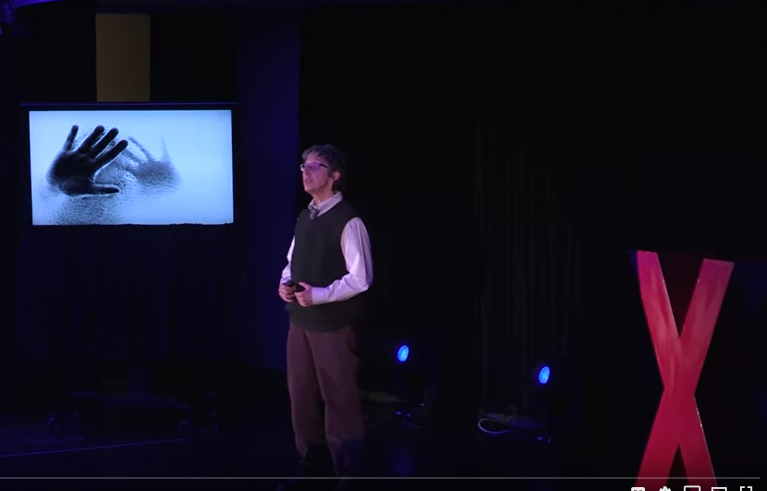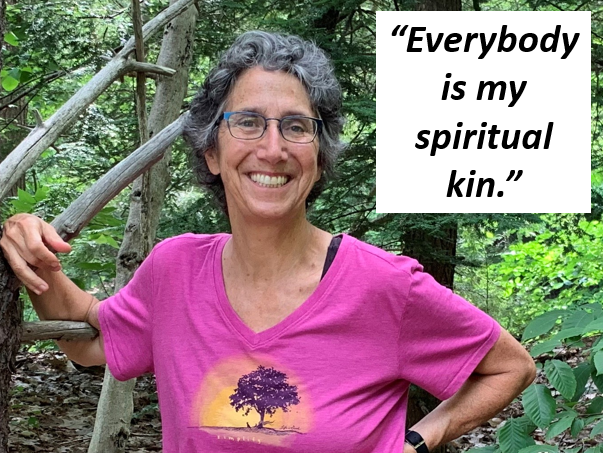It was clear to me really from the time I was three in the arms of a brown woman … if I have an image of mother Mary, the mother of God, I always talk about Sarah Cunningham …She embodied that great maternal God love.
Leaf Seligman refers to herself as a “translator of metaphors”. The descriptor speaks to her unique gifts as restorative practitioner, teacher, preacher, and author finding words that bring understanding to the complex and sometimes inexplicable human experience. Our metaphor-filled conversation for the third installment in the Blue Roads Changemaker Series exemplifies a soulful awareness that allows a body to transcend the space from good neighbor and engaged citizen to heart-centered and inspired changemaker.
Leaf’s perspective and work across turbulent times illustrate the struggles for self-understanding and solutions to obvious injustice alongside a unique ability to find herself in the suffering of others that fueled a determination to use her voice to inspire and advocate for change. Her particular “Homegrown Solutions for a Patchwork World” (Blue Roads’ slogan) are evident as she uses her linguistic gifts and faculties to put life’s challenges into words that promote understanding, engagement, compassion and ultimately, justice.
This longtime resident of New Hampshire can still slide easily into a Tennessee drawl that authenticates her southern roots when the circumstance presents itself. In addition to reading the summary that follows, you will enjoy hearing from Leaf directly by watching the video of our conversation here:
Introducing Leaf, Homegrown Changemaker
Growing up in a reformed Jewish home as a young child amid the Civil Rights era of the 1960’s in Nashville, Tennessee gave Leaf a perspective of diversity atypical among her white neighbors and classmates in her “fancy private school.” In contrast to most around her, Leaf’s family was both politically and religiously progressive. As she reminisced about her childhood, she referenced “that wonderful line from Flannery O’Connor of the Christ Haunted South.”
Although she was Jewish while most Tennesseans around her were not, she refers to her upbringing as a “fairly assimilated kind of life” where her family ate bacon, had a Christmas tree and Leaf lived in fear of her conservative relatives discovering their transgressions. Her family was open with her about political issues of the time and provided reading material that fueled her interest in civil rights leaders like Martin Luther King, Jr. and, his wife, Coretta Scott King. Two critical incidents echo in her memory when she reflects on the origins of her passion for justice and change.
When she was in third grade, her class was assigned the privilege of organizing an assembly for the whole school. Six of the most articulate students were picked for delivering a report to the audience on the topic of their favorite famous American. Leaf was among the chosen and announced that she would do her report on the subject of the Reverend Dr. Martin Luther King, Jr. She heard this in response:
If she does that report on that communist n****r, riot maker, my father will pull me out of the school so fast, you won’t even believe it! He’s the vice president of “such and such” a bank and he’s on the board of the school!
Despite her immediate shock and disbelief at these words coming from a classmate, Leaf recalls a quick understanding that the girl who had spoken out with such hateful vehemence came from a family who was at once wealthy, educated and ignorant. Leaf thought that surely the teacher would acknowledge the inherent injustice in these remarks and use it as a teachable moment. What happened instead will never leave her.
The teacher asked Leaf to pick a different subject for her report. Leaf acquiesced and chose another person because she was given no alternative, but in the end stayed home “sick” the day of the assembly.
Two years later, while in the fifth grade, she was planning to meet the requirements of a book report assignment by talking about the biography of Mrs. Coretta Scott King. This time, her new teacher suggested she give that report to her privately instead of in front of the class.
These betrayals from otherwise “lovely…rational, responsible” adults may well have sown the seeds of Leaf’s earliest stages of activism and advocacy. She became keenly aware of racial bias and inequities around her. She noticed how the adult African American custodians were called by their first names while “even the white lunch ladies were Mrs. or Miss”. She noticed the affluent way in which her family lived while the…
African American folks (a couple of miles away) lived in tarpaper shacks without plumbing… I knew that, and I knew them, and we traveled those roads, the contrast was really big for me.
Solution-Focused Leaf
Gifted with the ability to notice and describe all that was happening around her, Leaf found her voice and capacity as a writer. She remembers writing a paper comparing the incidents of the Boston Massacre with the Kent State shootings that happened around her seventh-grade year. Thankfully, this time, she had a teacher who encouraged the depth of her thought and the breadth of her understanding of complex issues that repeat themselves across history.
Throughout her remaining teen years, Leaf continued to read extensively and formed strong opinions about the world around her. She found an outlet for those opinions by writing letters to the editor of her Tennessee newspaper. Her letters focused on serious issues such as prison reform, drunk driving and homophobia. Some of her letters met with strong, and not always positive, responses from readers. Still, she felt empowered by her ability to find an audience for her well-reasoned ideas about right and wrong.
Leaf received noteworthy recognition for raising awareness around social justice issues and inequality in print. The best letters to the editor were awarded “three stars” and the writers of those letters were invited to a banquet in their honor.
The year I won at 17 was 1976 because Mo Udall was running for president and he was the keynote speaker and I wrote about pretty heavy-duty issues.
The attention to her writing encouraged her to continue this practice throughout her life as she grapples with issues that matter to her.
Her 2019 book From the Midway: Unfolding Stories of Redemption and Belonging contains a series of related fictional stories about people with various “afflictions” exploited for profit. A traveling showman makes them into spectacles people pay to gawk at to make themselves feel better about the state of their own bodies and lives. As the author, Leaf treats her subjects with utmost respect, humility and appreciation while using her great gift for storytelling to cause her readers to find themselves in the bodies, minds and experiences of her characters. Her intention is to use this work as a tool to engage people in meaningful conversations about how people tend to marginalize, exclude, exploit and harm others.
You can find her book here: www.bauhanpublishing.com and get a taste of it by listening in to her extraordinary reading with musical accompaniment here:
Leaf’s Patchwork World
The Blue Roads concept of the “patchwork” is designed to convey the value of diversity. Leaf has never shied away from interaction with people different from herself even when the prevailing culture undermined those relationships. Her family encouraged cross cultural communication and appreciation by modeling their own capacity to appreciate difference and to build bridges. While she attended school with the children of white lawyers, doctors, and successful businessmen, she visited the communities of color that sheltered friends and families of those who helped in her home.
I went to that world knowing I wasn't …”a spy”, but I understood that I … transcended boundaries in my life quite a lot. I have moved sort of across the borders of different kinds of people and subgroups…I just think I was wired to be attuned to those things.
Her mother worked for the mental health department for a time which gave her exposure to individuals with developmental disabilities and occasional visits to juvenile court.
When I was 13, I spent a summer as a kind of junior counselor at a camp for children who were blind and visually impaired. When I was 15 it was a camp for children who were deaf and had hearing impairments or hearing loss.
As an adult this propensity for understanding the reality of another threads its way through her life and work. Self-reflective by nature and by cultivated habit, Leaf strives diligently to find herself in people with perspectives and experiences different from her own. Even when speaking of men who’ve committed hideous crimes and the correctional officers charged with containing them, she wrestles with how to see her own capacity to walk the path in their shoes. The most challenging for her are not those individuals with different eating habits or political views or opinions, but those who express a lack of empathy or a lack of ability to see the humanity and validity of another being’s life.
I think about hunters (who) I know would say…of course, there’s a moment that pains me when I stop a life to feed my family. It’s the person who might say, well, why would it bother me to go shoot an animal?…Everyone is my spiritual kin and as we all know who have families, we don't always like our cousins, but they're our cousins…I'm connected to everybody.…I can understand that we might share a common value and have a different strategy …to address that.”
Leaf the Changemaker
Leaf’s writing, in itself, is changemaking if readers use their time and attention to absorb and reflect her example of how to find ourselves in those around us. She models the practice of self-reflection and questioning with a gentle curiosity absent any hint of chiding. This kind of powerful changemaking comes into focus perhaps more “directly” in her work as a teacher and a facilitator of restorative practices.
“A kind of activism” is the way Leaf describes teaching. She uses her opportunities to teach a college writing class to help students grapple with issues like “religious pluralism in a global age”, “the downside of certainty”, and “how consumerism and overconsumption are destroying the planet”. In this way, she creates a platform to encourage students to think critically about their own lives, stories, beliefs and assumptions. By embracing subjects such as forgiveness, reconciliation, and restorative justice, she exposes students to a way of being that safeguards the interests and rights of people while witnessing the potential for redemption for each of us.
I talked about how we learn because I really wanted students to deconstruct their own education and become critical thinkers about how we educate or fail to educate or miseducate students.
Deconstructing our perspectives is central to her restorative justice work as well. Leaf has worked in prisons, adult diversion programs and with the juvenile court system to create restorative circles that bring those who have committed offenses back into their communities in ways that acknowledge the origins of harm while creating potential for inclusion. One such initiative was a temporary housing and mentorship program for women returning after incarceration.
A few years ago, I helped start a nonprofit …the goal of which … was to create a healing house for women coming out of the local jail.
Her 2016 talk at TEDxAmoskeagMillyard on the subject can be experienced in its entirety at the link below. Once again, we can see in this her great gift for using the power of story to unite us.

Leaf has aspirations for bringing the changemaking power of restorative justice into schools for the benefit of students from a very young age. She takes every opportunity to meet with school leaders and teachers to offer her services as a restorative practitioner, at the ready, to train teachers and help them develop a program appropriate for their classrooms. She knows, as wise educators do, that:
Kids …can’t come and focus on whatever they’re taught (if) they’ve got a million challenges at home and in their little bodies (that) aren’t being addressed.
While educators are aware that many children face trauma and come from dysfunctional families, they sometimes remain unaware of how trauma in their own lives plays out in their interactions with students. Leaf hopes to introduce trauma-responsive healing-centered practices in schools beginning first with teachers. By helping them to find alternatives to punitive approaches and using the wisdom of the circle and the community, Leaf is certain that behavioral challenges can be addressed with curiosity and compassion.
I need to be curious about the child’s unmet need at the moment. But (teachers say) I’ve got 24 other kids, what do I do with them? And I always say, why don’t you circle them up with a child who’s needing some help?
These kinds of questions foster the critical thinking we all need in order to take the most inclusive, restorative and peacebuilding steps forward. Whether we are children, teachers, prisoners or guards, Leaf knows that we are worth understanding from the inside out.
Leaf is working diligently on United Nations Global Goals #4 (Quality Education), #10(Reduced Inequalities) and #16 (Peace, Justice and Strong Institutions). Whether she names them or not, her work on these Sustainable Development Goals, among others, in her curious, determined and restorative way helps us to comprehend the metaphors of our own lives so that we can enter the stories of others in a manner that enriches and redeems us all.
Podcast: Play in new window | Download
Subscribe: Spotify | iHeartRadio | Email | TuneIn | Deezer | RSS | More



